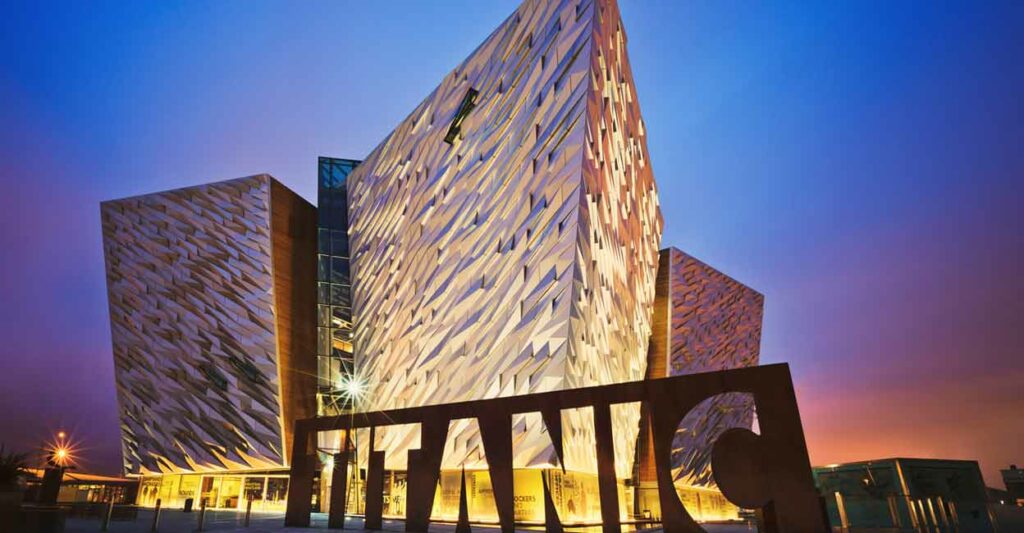This was a journey to the echoes of a monumental tragedy… The tear-wrapped stories of 1,512 lives extinguished not by an enemy, nor through bloodshed, but mortally frozen in a severe winter, more than a hundred years ago. The Titanic Museum in Belfast, the capital of Northern Ireland, offers more than just what happened and how.
It takes about one and a half hours from Heathrow Airport in London to reach Belfast. The Titanic was built in this city, renowned for its shipbuilding heritage. The River Lagan, which winds through the heart of the city before merging with the ocean, played a key role in the growth of the shipbuilding industry here. The climate is generally cold and damp, with drizzle that plays hide-and-seek, preceded by wet winds blowing in from the Irish Sea. Most of the buildings are from the Victorian era, featuring red brick walls and white-framed windows.
Harland & Wolff, the shipbuilding company that constructed the Titanic, was headquartered in Belfast. The museum has been built on the very land, handed over by the company in 2003, where the Titanic was originally constructed. This area, located about 2.5 kilometres from the heart of Belfast, is now known as the Titanic Quarter.
The museum opened in 2012 to mark the centenary of the Titanic tragedy. The ticket price is around Rs 2,500. Here, both the legendary Titanic, built from steel and the even greater tragedy that sank it beneath the iceberg are on display. The museum stands as a solemn reminder that no journey is guaranteed to reach its destination.

Harland & Wolff, the shipbuilding company that constructed the Titanic, was headquartered in Belfast. Photo: iStock/todamo
A hull that tells a story
The museum is shaped like a ship’s hull. The sharp front-most part of a ship is called the bow, and the adjoining body is the hull. The museum features four hulls pointing in four directions, each measuring 38 meters in height, matching the Titanic’s original hull height. The outer walls are clad in silver and aluminium panels shaped like waves. During the day, sunlight reflects off the surface, giving the impression of waves, while at night, the illumination creates the appearance of a ship gliding through water. From above, the structure resembles a beautiful four-pointed star. In front of the museum stands Titanica, a bronze sculpture that evokes a girl poised to leap into the sea.
From wave to wave
The museum features nine galleries, enriched with light, sound, and special effects that etch the Titanic’s legend into visitors’ minds. The two-hour gallery experience unfolds in the following way:
1. Belfast: Life in Belfast during the 1900s, complete with period fashion and professions such as shipbuilding and linen weaving in the backdrop.
2. Shipyard Journey: A ride in a small cable car through the shipbuilding factory. The timeline of the steel dream begins with the keel laid on March 31, 1909. Workers and their methods are showcased.
3. The Launch: The historic launch of the Titanic at the Belfast dockyard on May 31, 1911, was celebrated with great fanfare—photographs of the event, the guests, and the massive crowd.
4. Great Interiors: The ship’s luxurious interiors, including grand first and second-class cabins, furniture, and curtains. The pantry and utensils are used for serving meals. Although the museum features the famous Grand Staircase made of oak for first-class passengers, visitors are not permitted there.
5. The Maiden Voyage: On April 10, 1912, RMS Titanic set sail from Southampton, England, to New York, witnessed by nearly 100,000 people. A total of 2,208 individuals, including crew, were aboard. The week-long journey spanned around 2,700 nautical miles (5,000 km).

SS Nomadic was used as a ferry boat in Cherbourg, France, to carry passengers and luggage from the port to the Titanic, because the Titanic was too big to come close to shore. Photo: iStock/photobyK
6. The Sinking: Small icebergs drift through the North Atlantic Ocean on the night of April 14, 1912. The water temperature is -2°C. Inside the specially designed gallery, the cold is bone-chilling. The atmosphere is steeped in death. Visuals are also similarly arranged using light and sound. The ship receives multiple wireless warnings—the heavy toll due to overlooked details. 11:39 p.m. Ominous clouds loom. An iceberg, twice the size of the boat, appears along the shipping channel, moments of chaos shortly after the accident at 11:40 p.m. Lifeboats and death throes. After two and a half hours of helplessness, the ship splits in two and sinks along with 1,512 lives into the Atlantic Ocean, 12,500 feet below.
7. Never Again: Newspaper reports following the tragedy. Major publications from England and America of that era. Survivor testimonies. The names of 1,512 souls claimed by the Atlantic. Both nations launched investigations, resulting in decisions.
8. Myths and Legacy: Numerous historic and creative works inspired by the Titanic tragedy. Books, documentaries, and films. Scenes from the 1997 movie Titanic are featured.
9. The Wreck: Titanic remained undiscovered at a depth of 12,500 feet. American oceanographer Dr Robert Ballard discovered in 1985 that the Titanic wreck was broken into two. The underwater scenes are presented in 3D in the museum.
As with all tragedies, this museum journey — from the shipbuilding factory in Belfast to the depths of the Atlantic Ocean — leaves many questions unanswered. Who was truly at fault? Emerging from the museum into the cold drizzle, shrouded in darkness, one feels as though the cries of sorrow still echo from the ocean’s depths, as if the air itself is frozen with the scent of death.
Source link



